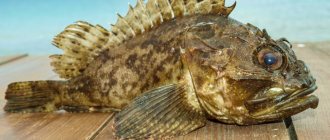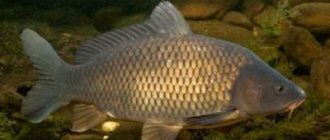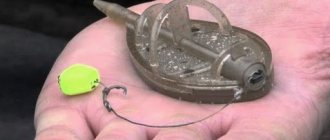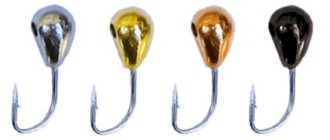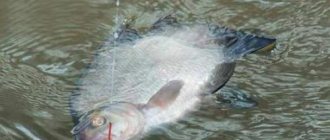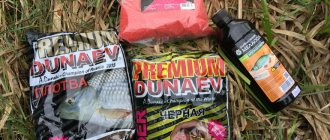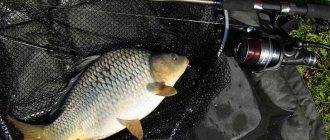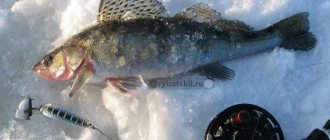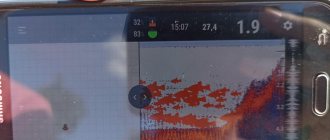CONTINUATION of the series of articles on long-casting techniques from Terry Edmonds. Previous materials can be found at the links ( PART 1, PART 2 ).
As of today, the spod/rocket rod is perhaps the most popular “tool” (among carp fishermen) for delivering virtually any bait to the future fishing area at a distance of up to 150 yards (137 meters)! That is why, in this article (the 3rd part of the series of materials) I want to explain to beginning carp fishermen how to effectively feed the most remote points on reservoirs using long-range casting of “missiles” (using a spod rod). I will also talk in detail about how to correctly choose the right equipment, what types of “missiles” are (and bait mixtures for their use).
Choosing a Rocket Rod
The most important condition (when choosing a carp rod for long-distance casting) is a high-quality blank with a test weight of at least 4.5lb, because
Quite difficult conditions for casting bait rockets weighing up to 7 ounces (i.e. up to 200 grams), as a rule, instantly reveal all the weak points of the rod. By the way, many people who carefully watched my demonstrative casts saw this with their own eyes. As for me personally, right now, to perform any work related to feeding remote areas of the reservoir, I use forms from Liverpool, because they are really reliable! Also, Horizon carp rods (from FOX) have never given me any problems, with which I have successfully delivered my rockets to distances of up to 150 yards. I will definitely emphasize that the most competent solution (in the process of choosing forms for long casts) is rods made TO ORDER, i.e. maximally/accurately meeting exactly your strict/individual requirements. I noticed that recently most of the rocket rods (on display in fishing store windows) have handles that are too short, which inevitably leads to a downward displacement of the axis of rotation (during long/power casts). And this is fraught with a significant increase in loads on the form (especially when working with bait rockets). How can I solve this problem? First of all, I would advise you to hold the butt of the rod directly under your armpit and stretch your hand along its form. And where your hand ends up will be the most ideal place to install the reel/holder (which will normally shift the axis of rotation of the fishing rod, thereby facilitating the process of casting very heavy rockets/feeders).
Plastic or metal feeder?
The most popular are cage feeders, which ensure rapid leaching of bait and thereby attract fish. For their manufacture, a mesh of plastic or metal with different cell diameters is used. The larger the holes, the faster the food will come out.
Metal feeders can be rectangular, round or square in shape. At the same time, they have a number of advantages:
These products sink to the bottom faster, which is important in ponds where many small fish live. The metal mesh, as it were, cuts through the thickness of the water layer and falls to the bottom in a fraction of a second, without attracting small things, which are most often found in the middle horizon. These structures are more resistant to underwater currents
If you choose the weight wisely, the feeder will be securely in one place without moving along the bottom.
Strength. The steel frame can withstand impacts from stones and other objects that are under water. Even if the body is slightly bent, it can be easily straightened by hand.
Feeder cage
There is only one significant drawback to steel cages. These feeders just float up much heavier than the plastic ones. Sometimes they need to be pulled out with force through aquatic vegetation that is located at the bottom. This drawback often reminds itself during fishing on the edges, when the net simply clings to the “step”.
Another disadvantage of metal structures is the formation of rust in places where the protective coating has peeled off. After prolonged use, they need to be painted with moisture-resistant paint.
There are no these problems with plastic products. The feeders are not subject to corrosion, float up easily, can bypass obstacles, and practically do not sink into the silt at the bottom. These designs are perfect for fishing in still waters, as well as in places where a good bite can only be maintained through active feeding.
Even better buoyancy can be given to plastic products by wings, which have some designs. In addition, they raise the plane of the feeder, preventing it from sinking into the bottom silt.
It should be noted that wings do not always help when fishing, and sometimes create some inconvenience because they reduce stability. If the equipment is used on a river, then after casting the winged structure carried away by the current will be away from the feeding area. It is for this reason that fishermen in some cases trim the wings with a knife.
Read: Bream tackle for fishing from the shore and from a boat
Diameter of rings on the form
The optimal set of guides for a spod rod should always start with a 50mm bottom ring (in diameter) and end with a 16mm tulip. Such large sizes of the lower ring can actually provide us with a significant increase in casting distance (when using “big-pit” reels), despite the fact that some anglers do not agree with this. Take my word for it, at many international competitions where I competed with the best casters in the world, literally everyone used exclusively large rings (at least 50 mm in diameter). In addition, I very often used these very dimensions to break some British records. I believe that these facts will be quite enough to convince you that I am right?
Reels and braid
A wide range of many fishing stores today offers a very wide selection of carp reels, ideal for feeding remote points on a pond (by casting rockets with spod rods). The most important characteristics (and advantages) of these reels are optimal line laying (plus a very convenient spool clip), high pulling force and decent rewind speed. Personally my favorites are i.e. The reels that I use most often (and which have NEVER let me down in my entire fishing practice) are the Shimano Biomaster models. These are excellent products that can do the job perfectly, and are not (!) too expensive (compared to similar models, but with very steep prices).
Rocket to carp
Read reviews about the article
I remember what a revelation the fishing strategy of Tim Pasley and Steve Briggs, winners of the 2000 World Cup in carp fishing, which was then held in France, became for me at the time. While the other participants were playing tricks with the bait, trying their best to maintain silence and carefully throwing several boilies into the pond, the British relished and even with some excitement splashed the hefty “rocket” feeder through the water about seventy meters from the shore. The sound of it falling into the water spread around for tens of meters, causing the carp fishermen of neighboring teams to flinch, and the imperturbable representatives of Foggy Albion every now and then brought another trophy into the carp landing net. This is how I first saw in action the method of feeding carp using a “rocket”. Eduard, I noticed that you quite often use a “rocket” for feeding, not only on foreign reservoirs during official competitions, but also on lakes and ponds near Moscow, and even on Akhtuba. What are the main advantages of the “rocket” compared to other methods of delivering bait to the fishing point? The standard task that an angler faces when fishing in most carp reservoirs (ponds, lakes, reservoirs, river bays) is to thoroughly feed the fishing area at a distance of 60-80 m from the shore, or even further. If you have a boat, the problem is partially solvable: starting feeding can be done from it, but feeding the fish using a boat, for example, after catching another specimen, is quite tedious. A slingshot is a poor assistant in this matter; its range is limited to a distance of 30-40 m; a large catapult on a tripod allows you to send bait further away - seventy meters. You can, however, resort to tricks and, by adding a little water to the grains or ready-made bait, freeze a certain number of bait balls ahead of time. Such pieces of ice, launched from a slingshot or catapult, fly much further, and in the water the ice instantly melts and only a pile of bait remains at the bottom. But is it worth talking about the disadvantages of this method, especially if you are going to spend more than one day on the shore of a reservoir! The “cobra” tube is without a doubt one of the longest-range devices for casting bait and, with good technique, can deliver boilies up to 120 meters. But, alas, this device is highly specialized: ready-made bait, grains, pellets are all not its profile. And the boilies themselves for catching carp must be perfectly round, otherwise they will deviate from the intended trajectory when casting. “Rocket” allows you to feed at a long distance with almost everything that modern fishermen use to attract carp: whole or cut into pieces boilies of any shape, various grains from corn to small hemp, granulated feed (pellets) and even viscous ready-made bait mixtures. Moreover, with the equipment supplied, the accuracy of such feeding is very high, and the charge that the “rocket” can carry reaches 0.35 kg! I won’t lie, there is one unit that can largely replace the “rocket” feeder - this is a radio-controlled boat. But the cost of this miracle of fishing equipment is usually more than $1000, so it is available only to a limited circle of modern carp anglers. In addition, one trip of this bait barge to the fishing point, which is located, for example, 100 m from the shore, and back, allows for a dozen casts with the “rocket” feeder during this time. Of course, a radio-controlled boat also has its advantages: it allows you to delicately deliver bait and hooks with a nozzle exactly under the branch of a tree hanging over the water on the opposite bank of the pond, it is capable of delivering equipment to distances that are prohibitive for casting, when you already have to take up binoculars, and simply irreplaceable for carp anglers who experience chronic problems with accuracy and casting range. But at most official competitions, including the 1st Russian Carp Fishing Championship, which will be held in July this year in the Lower Volga, the use of these devices is prohibited, so the choice is up to the anglers themselves. What is the principle of operation of the “rocket” and how to choose the right feeder for a specific bait and fishing conditions? All feeders are divided into two large classes: floating and sinking. The body of any “rocket” feeder is hollow, closed at the bow. Photo 2 shows a simple floating feeder. Through the hole in the tail part, bait is placed into it. Here in the tail there is a fastener through which the feeder is connected to the fishing line.
During casting, the bait does not spill out of the feeder due to the force of inertia, which pushes the bait into the front part of the feeder. The aerodynamics of this device are impeccable, and the tail stabilizers of the “rocket” do not allow it to somersault in flight and away from the target. But as soon as the floating feeder splashes down, it, like a float, takes a strictly vertical position in the water thanks to a piece of foam or some other floating material placed in its bow; The bait pours out freely and the feeder floats up. Its appearance on the surface of the water indicates that the cargo has been unloaded, so very often the bow of the “rocket” is painted in a bright color. But such a “rocket” is only good for feeding with various grains: corn, hemp, beans, peas, as well as pellets. Purchased bait moistened with water will stick in it, and the feeder will return to the owner only partially emptied. To prevent this from happening, use feeders with holes along the entire length (photo 3).
They are suitable both for grains and pellets, and for standard bait mixtures, because thanks to these holes the bait is perfectly washed out of it. To be honest, I use this “rocket” more often than others, because I prefer a combined bait consisting of a mixture of pellets, grains and ready-made carp bait with the addition of whole and halved boilies. will impress even the inexperienced: three casts and a kilogram of bait on the bottom. No matter how much we talk about the force of inertia, when casting grains and pellets using feeders with an open back, some amount of bait still spills out. To put an end to such waste, with drop-down rear flaps. An example of such a “rocket” is shown in photo 4.
After loading, the flaps of this device are securely closed, and during flight, it does not waste its valuable contents. But when falling into the water, when the tension of the fishing line weakens and the feeder assumes a vertical position, the rear flaps swing open and all its contents spill out freely. If there is a need to thoroughly and accurately feed the fishing area with boilies, the “rocket” shown in photo 5 is ideal.
This feeder has a narrow, elongated shape and allows for a long casting distance. With the equipment supplied, it can be launched at 130-140 meters. At such a distance, it is no longer possible to achieve good accuracy using the Cobra. This feeder does not require any holes in the body or rear flaps: the boilies are securely held in it during the flight and spill out freely as soon as the “rocket” splashes down. A separate conversation about sinking “rocket” feeders (photo 8).
They are usually used on the current. They are designed in such a way that they can lower the bait into any fishing horizon and even to the bottom. The moment it touches the surface of the water, the back cover flies off the feeder, and if at this moment you do not hold the line, but allow the “rocket” to freely sink to the bottom, then the contents remain inside until the angler lifts the line with the rod. There are situations when you have to use a sinking “rocket” when fishing in still water, for example, if you need to feed a point with light commercial bait, which contains a lot of suspended particles, as they say, to create a cloud of turbidity. If you throw such a “boiling” bait with a floating “rocket”, it will never sink to the bottom and will become an excellent prelude for catching... bleak, but not carp. Another option for using this feeder in closed reservoirs is fishing with a sinker feeder, called “METHOD” in English. rocket sinking nozzle. with a hook nearby and a lump of bait at the bottom: this kind of equipment looks like Imagine,> allows you to scatter several similar “piles” around, not only attracting the carp, but also lulling its vigilance. It is clear that the bait with which the feeder sinker is filled and the one we load into the “rocket” should be close in composition. So, as you can see, each feeder has its own purpose. This method of feeding was invented by the British, so it is not surprising that the highest quality feeders are produced in the homeland of the founders of modern carp fishing. Such “rocket-building” companies as GARDNER TACKLE, FOX, MCF have been especially successful in this direction. With such a variety of models, I’ll tell you frankly, it won’t take long to get lost. Which feeder do you personally use most often and what do you fill it with? As you already understand, there is not and cannot be a feeder for all occasions; the choice of model depends on the specific reservoir and time of year. For example, in spring and autumn, and also if the fish is inactive, then first of all I try to pull it to the fishing point. In this case, I often use up to 50% branded bait mixtures. Thanks to the presence of flour components in the finished bait, that very “appetizing cloud of turbidity” that attracts fish so much is created at the bottom. Moreover, it is not a fact that large individuals will immediately rush to the bait, but small things will definitely be collected. I cannot judge with certainty exactly what reflexes are triggered in carp, but I have often noticed that a cluster of feeding small fish sooner or later attracts larger specimens. It makes sense to feed pure grains and especially boilies if the fish is actively moving and feeding. In this case, the main task is to stop it and hold it longer near the hooks with the nozzle. Grains and especially boilies can be fed at extremely long distances, where a heavy feeder for viscous bait will no longer reach. It is not a problem to get grains at agricultural markets, the only important thing is that they are not treated with chemicals against rodents. Preparing them is quite simple: I soak them in water for a day, and then cook until they become soft. You can cook corn, beans, peas, etc. this way. The hemp should be removed from the heat as soon as it begins to crack. If you want to give the grains some additional flavor, you should not add the flavor to boiling water, subjecting it to heat treatment. The best way is to drop it into a plastic bag in which the bait will be stored, at the rate of 5 ml per 1 kg and mix thoroughly. It is best to store this package frozen. Before fishing, when the grains taken out of the refrigerator are defrosted, they absorb odors best. A good filler for a rocket feeder could be PRILL bird food, which contains various grains, which, as it turns out, are liked not only by parrots, but also by carp. I almost always add pellets to the bait. If it is not possible to get hold of a branded product, domestic feed in the form of pressed granules is also suitable. The good thing about branded pellets is that it disintegrates quite quickly at the bottom, not saturating the carp (as happens when you feed pure corn), but causing it to spin around in place in search of something more substantial, for example, my boilie on the hook. As you can see, choosing the right filling for a “rocket” depends on many factors (by the way, and on the list of ingredients that the fisherman has at his disposal). On my favorite ponds near Moscow, I most often use a large feeder for viscous bait, filling it with approximately the following composition: ready-made bait - 50%; boiled hemp - 40%; corn - 10-15%. Sometimes I add whole or cut boilies and pellets to it. I lightly moisten the mixture by first adding about 5 ml of my favorite plum flavoring to the water. You said that this feeder can deliver about 0.35 kg of bait to the fishing point at a time, but ordinary carp rods clearly cannot cope with such a weight of bait being thrown! You are right, for the “rocket” feeder they produce special 12-foot rods with a test weight of 4.5 to 6 Lb or more. With an ordinary carp stick with a power of 3.5 Lb, you can, perhaps, risk casting only a rocket for boilies, the weight of which, when loaded, usually does not exceed 120-150 g. For other feeders, you will have to purchase a special fishing rod for feeding, which, I must admit, is all- it is still too “oaky” to be used directly for fishing. Although bait rods also have their own classes, from light 4.5-foot to 7-foot “super heavy”. Of course, you can get “sticks” of different power for all types of feeders, but personally I make do with one middle-class bait rod. There are no special requirements for the reel of a bait rod, as long as it is equipped with a wide spool for long casting. The number of bearings and its traction characteristics do not play a role; the correct choice of fishing line is much more important. Just like when equipping a regular carp fishing rod, a shock leader is needed that prevents the line from breaking when casting, but here increased demands are placed on this element of carp gear. This is understandable, because the load on the line when casting increases two or even three times. If you use a monofilament shock leader, it must have a diameter of at least 0.7 mm. But how to connect it with the main one, the diameter of which is only 0.27 mm? The knot at the connection point, passing through the guides of the rod, will become a serious obstacle when casting. This problem is partially solved by using a shock leader made of braided fishing line, but the best solution is a conical shock leader made of monofilament. At one end, the one closer to the feeder, its diameter will be 0.7 mm, and at the opposite end, at the junction with the main line, only 0.35 mm. You can connect fishing lines of 0.35 and 0.27 mm using the knot shown in Fig. 9. It is also suitable for connecting the main fishing line with a braided shock leader. The total length of the shock leader, as usual, corresponds to two rod lengths (Fig. 10). Before each cast, as with a regular carp rod, you need to make sure that the knot is located close to the reel skirt, and if this is not the case, you need to rewind the last few meters of line by hand. Otherwise, the upper turns may get caught on it when casting, which is fraught not only with a decrease in range, but also with more serious troubles. Is the technique of casting a “rocket” different from a regular carp rig? The basic movements—the position of the arms, legs, and body—are the same as when casting a conventional rig, but since the weight of the “rocket” is much greater, some nuances arise. Firstly, when casting the “rocket”, I make the line hang shorter, only thirty-forty centimeters. This makes it easier to set the correct trajectory for this aircraft, along which it will move thanks to the stabilizers located in the tail. Secondly, you need to take care of protecting the finger that presses the line before casting by wrapping a strip of adhesive tape around it. Movements when casting should be smoother, since all elements of the tackle experience increased load. When feeding a fishing spot, I usually focus on the marker left in the water, but you can use another technique: after making an accurate cast, hold the line in a clip on the reel spool and make subsequent casts at a precisely specified distance. Unlike conventional carp rods, the clip technique works here, but only if the angler has decent casting technique. If there is a “flight”, you can break the fishing line and lose the “rocket”. What's your typical baiting strategy if you're fishing at, say, your favorite pond? As a rule, I start feeding using a mixture, the recipe for which we have already discussed here. As you remember, it contains up to 50% branded bait, which attracts fish from afar. To each fishing point discovered using a float marker, I send a dozen “missiles” with a capacity of approximately 0.25 kg of bait. I always use ready-made groundbait in the starter feeding mixture when there are no obvious signs of carp activity. If the fish shows itself and splashes, there is no need to add flour bait; you can feed it with clean grains or boilies in this place. When fishing in cold water, the volume of the starting feed needs to be slightly reduced. In the future, I throw up one or two “missiles” of grains or pellets every hour. If the bite alarm detects a pull, i.e. The carp has shown interest in the bait on the hook, but until it decides to swallow it properly, in my opinion, it’s not worth giving it another “rocket attack.” But if you catch a fish, you can immediately send up to half of the starting feed into the reservoir. Massive feeding can be resumed every 4-6 hours of continuous fishing. Methodical feeding always pays off. Remember the international competition on Lake Fischabile in France, when the English team, led by the legendary editor Tim Pasley, persistently plopped a “rocket” filled with pelets into the same place, and how brilliantly it won, with a result of more than 200 kg of fish. I am absolutely convinced that Russian carps love to eat heartily no less than French ones, so competent artillery preparation before the battle can decide the success of the whole affair. Article from the magazine "Fisherman Elite"
Article tags: rocket, English, boilies (go to tags section)
Some valuable tips
- To avoid the formation of “beards”, before the very first cast of the spod rod, lower the reel into the water so that the braid is properly wetted.
- In order to prevent the line from being cut off on the clip, you can wrap a little electrical tape around the part of the braid that goes under the clip.
- In addition to braid, you can also successfully use mono/filament line (by the way, it is more budget-friendly and does not create problems with “barbs”) with a diameter of 0.26-0.28 mm (together with Whiplash 65lb leadcore).
- When making virtually any long cast (i.e. not just bait rockets) always use a leather fingertip! Otherwise, you risk getting a very dangerous cut. Personally, I prefer to use finger guards from .
Long casting technique
By and large, the technique for long-distance casting of rockets (using a spod rod) is exactly the same as the technique for casting overhead (described in detail by me in the first part of the series of articles). Except for some nuances. After sending the rocket into flight, you need to immediately direct your rod so that it is positioned exactly along the line along which the fishing line coming off the reel “flies”. At the very end of the cast, raise the tip of the rod as high as possible (i.e. position your blank - almost vertically). Once the braid (or mono/line) is tight enough (and you “feel” the rocket), immediately return the rod to a horizontal position. This will allow you to both normally “absorb” the impact of the fishing line on the clip and ensure the rocket splashes down with minimal splash.
As for optimal casting accuracy. While the line is clamped in the clip, its distance will be equal to the distance at which your marker float is located (or a pre-targeted area). In general, if you accurately follow all the necessary instructions for long-distance casting overhead (refresh your memory of my 1st article in the series or watch the VIDEO below), then maximum accuracy of the rocket's flight will be guaranteed to you!
Correct shooting technique
This concept includes two components: aiming and the hunter's stance. By mastering both correctly, you can achieve amazing results. Experienced hunters are able to hit a target that is not standing still. And it’s also not uncommon to shoot while you’re on the move.
Read How to deliciously salt sockeye salmon
In this light, two aiming techniques are worth considering.
Instinctive shooting
This method is based more on imagination and feelings, although it does not abolish the laws of physics. Aiming is done with both eyes, and the slingshot is controlled by sensations, because it is completely outside of direct gaze. When the hunter feels that the direction of fire has been chosen correctly, by lowering his hand with the leatherette clamped in his fingers, the trajectory and flight range of the projectile is adjusted.
The undoubted advantage of this aiming method is that the shooter does not care which eye he sees better. But the disadvantages include two facts:
- If a hunter is poorly able to imagine the trajectory of a projectile, he is unlikely to achieve any success. This is the very imagination on which the method is based.
- The second is the fact that after replacing a worn out harness, you will have to spend some time shooting.
Mastering this method requires long training. But having mastered it, the hunter is unlikely to leave the forest without trophies.
Aiming with an eye
Installing a landmark on a slingshot for hunting can significantly increase the efficiency and accuracy of shooting even for an inexperienced shooter. But there are some nuances here:
- You will have to aim with one eye, the one that is sharper.
- The reference point should be set slightly to the side, since the hand with the skin will be in close proximity to the face, and this fact can negatively affect accuracy.
- When choosing a reference overlay, you need to ensure that it matches your individual color sensibilities.
The essence of aiming with an eye comes down to the following: three points must be lined up on one line. Eye, sight and target. The flight range is determined in the same way as in the previous method.
A well-made and individually adjusted eye can easily be used with several types of slingshots, simply by moving it from one to another, which can significantly improve hunting results.
Hunter Stance
When hunting with a slingshot, sometimes there is no time left to take the correct stance. Find support for your feet, fall on one knee, or vice versa, straighten up. All these movements in the forest, where any movement means danger for the animal, can scare away the prey, and you will have to spend some more time searching for it. Therefore, the hunter’s stance comes down to two concepts, from which the method of aiming follows.
- In move. Experienced shooters advise not to try to keep the sight exactly on the target while moving. It is almost impossible to do this, and by and large it is not required. The sight can move along a certain trajectory, the ideal example of which would be the infinity sign - an eight falling on its side. The junction of the imaginary lines will be the aiming point. As soon as the shooter feels that the movements have converged at this point, and it, in turn, coincides with the target, a shot is fired. "Infinity" is not the only option. The trajectory of the sight should be selected individually.
- Fixed aiming. At first glance, nothing complicated. Point the sight at the target, make sure that all three points coincide and release the skin. But there are subtleties here too. Learning to hold a tense slingshot straight throughout the entire time of sight is not easy. And one more thing: between the moment when the sight found the target and the shot, the delay should be 5, maximum 7 seconds. In the forest when hunting, this method is rarely used, since you can’t sit in an ambush with a slingshot, so this method of aiming is more suitable for sports competitions and shooting.
In general, there are nuances. However, having mastered all these skills, you can safely take the slingshot into service.
Types of rockets
On the modern fishing market there is a large assortment of bait rockets (both “closed” spombs and “open” spods). Personally, I tried many options, but finally settled on only a few of them, which I consider the best of the best. So, for example, for long-distance and most accurate casts, most often I use the Korda Skyliner spod model. Thanks to its unique geometric shapes (with a slightly weighted nose), as well as excellent aerodynamic characteristics, it not only flies well, but also gets exhausted quite quickly. I mainly use it to deliver heavy bait up to 150 yards (137 meters). Large holes in the body of this rocket allow my mixtures to be quickly unloaded, leaving a “bait trail”.
For extreme/long-distance casting of boilies, I always use a “boilie” bait rocket from. Just like the previous model - it reels out well (if you lift its back part) and optimally/accurately delivers boilies up to 16 mm in size to the target. Only at the very beginning do I load hemp into it, and then boilies, after which (immediately before casting) I always immerse it in water. Thanks to the weighted body (due to relatively thick walls made of durable plastic), this rocket is absolutely not afraid of side gusts of wind.
For successful delivery of dry (bulk) mixtures or maggots (at a distance of up to 130 yards / 119 meters), of course, I use “spods” without holes in the body (all from the same). The rocket models of this particular company (produced in different types/sizes) are distinguished by the fact that they have a “release mechanism” (immediately after casting), which allows them to be deployed (immediately before reeling out) - with the bow part towards the shore. This is actually an ideal solution for rockets without holes, greatly facilitating the process of releasing bait from the rocket.
And finally, for long-distance casting of very liquid mixtures, I use rockets from Gardner (both small “pocket” models and the largest - XXL, depending on the amount of bait I deliver). They fly, of course, excellently, but they wear out very badly. That is why I use them less often than others. And this is due to their advantage, such as a very high level of buoyancy, which allows liquid mixtures to flow out evenly from the cavity of the rocket.
Helpful advice: in order for your rocket to fly far and smoothly, and also hit the target accurately, load it 3/4 (of the total volume).
Bait rockets
Missiles – “feeders” – are special containers, which in their design actually repeat the aerodynamic shapes of cruise missiles (streamlining, the presence of stabilizers and other nuances). Their main bodies are created from high-strength types of plastic, made from especially buoyant materials, which, after splashing down the rocket, contributes to its inversion (tail part down) and, accordingly, maximum emptying of the bait “charged” inside it.
It is worth noting that the very appearance of rockets (in the 80s of the last century) pushed carp anglers to the idea of creating a separate type of (even more powerful) carp rods, which were called spod/rocket rods. And then marker rods (markers) appeared, but that’s another story.
Again, according to design, all existing bait rockets are divided into 2 large groups: “open” (spods) and “closed” (spombs). Considering the fact that the SPOD missile appeared first, and then the SPOMB (in 2010), it is logical to assume that the latter is a modernized version of the previous one. However, in fact, there is some grain of truth here. But, nevertheless, the main goal of the developers was not to improve the spods, but to create a new tool that provides POT bait. Thus, to this day, there is no more effective means of creating a “bait trail” than SPODS. Equally, it is difficult to find an alternative option for point baiting (voracious carp at long distances) than SPOMB.
Carp SPOD rockets
As mentioned above, spod rockets for bait, figuratively speaking, have an “open” body design. With special slots and an open bottom, through which, in fact, all bait elements are “loaded” inside (closer to the nose). Despite the fact that the force of inertia (during a rapid flight) will keep the bait in the cavity of the body, (according to the advice of the developers) it is better, after all, to fix it with a “stopper” of some kind of bulk materials.
Carp SPOMB rockets
Unlike spods, spomb missiles are tightly “closed”. This completely eliminates the “leakage” of even the smallest bait elements and significantly improves flight properties. You can safely load even bulk ingredients into them, since they will be “released” only at the moment when the “spring button” (on the nose of the rocket) is activated upon impact with the water surface. The entire length of the housing will instantly open (into 2 equal parts), after which all your bait will be emptied at a strictly defined “point”.
Long-range "Croatian" missile
As you can already understand from the name itself, these missiles were invented by Croatian carp fishermen (in 2000). Thanks to their original design, they not only have excellent aerodynamic properties, allowing them to cast bait over record-breaking distances. But they also get exhausted easily! It is enough to pull the rod towards you (pulling the slack line), and the rocket turns its “nose” towards the shore. Its very light and transparent body is so durable that it can easily “survive” even a collision with a passenger car. This is confirmed by videos on the Internet.
Sources
- https://intellifishing.ru/snasti/raketa-prikormki-ryby
- https://IaRybak.ru/prikormka-i-nasadki/prikormochnaya-raketa
- https://kharkiv.fishing/fishlib/articles/Terry_Edmonds-LongRangeSpod/
- https://carptoday.ru/turnir-sredi-prikormochnyh-raket/
- https://carpfishing.ru/stati/snaryazhenie-ekipirovka/sredstva-dlya-dostavki-prikormki/
Groundbait mixtures
At the moment, there is already quite a large number of different mixtures for bait rockets, many of which have literally become favorites of carp anglers. As for me personally, all my mixtures are very simple. As a rule, there is no reason for me to take any complex variations with me, since I prefer to go out – strictly for short fishing trips. Besides, I like to use only things that I am 100% confident in!
So, my classic bait mixture consists of 60% hemp and other grains, which normally attract carp, and are better unloaded from the cavity of the rocket. The remaining 40% is pellets (usually of various diameters), crushed boilies and necessarily a certain amount of bait used (whatever it may be). At the very end, I add a few liquid flavors to this mixture (for example, molasses from), as well as a little salt and sugar.
Dependence of composition on time of year
For experienced fishermen, it is no secret that the composition of the attracting mixture, which can influence the bite, also varies depending on the season of the year. Factors such as water temperature and turbidity, the presence of an accessible food supply or its absence, radically change fishing conditions. And this entails difficulties in preparing an effective bait table that can quickly and for a long time collect fish at the fished point.
The composition of the bait is changed not directly, guided purely by calendar dates, but by analyzing the weather conditions, the prevailing food supply in the reservoir for a particular fish at the time of fishing, as well as taking into account the taste preferences of the intended prey based on the practice of past fishing trips, as a result of which the angler received a positive according to the intensity of bites the result. In continuation of the material, we will dwell on the nuances of preparing bait in different calendar seasons.
Winter
Winter is a time when bodies of water are covered with ice, which reduces the water temperature and the intensity of light penetration. Most fish species become inactive due to poor nutrition and lack of oxygen in the water. Winter fishing baits are characterized by increased calorie content, lack of rich flavors and lighter tones of color, which should stand out at the bottom. The compositions include more animal components, bloodworms, chopped worms and maggots. Feed fractions are used as finely as possible. The fish is not active and feeds in small portions. The complementary feeding itself is given in small doses, trying not to overfeed the quickly saturated fish.
Spring
With the arrival of spring, the fish become noticeably more active, and most species preparing for spawning exhibit an enviable appetite, moving intensively throughout the reservoir in search of food. Food with an attractive aroma for fish helps to detain a school or attract individual individuals to the fishing zone. As the water warms up, a mass of animal plankton appears in reservoirs, in places where they accumulate, fish feed. You can attract fish to the spot by feeding with animal-based attractants, adding fish oil, blood, bacon and similar flavors to the mash.
Bait for fishing in the spring attracts fish not visually, but more by smell, therefore, significant attention is paid to the selection of flavoring. The dusting effect is not important in view of the already muddy spring water, but you can collect and hold fish with a stable aroma. It is difficult to feed fish in the spring, so feeding is made rich, with the obligatory presence of an animal component
It is difficult to saturate fish in the spring, so feeding is made rich, with the obligatory presence of an animal component.
How to make bait in summer
In summer, warm water and water areas richly saturated with easily accessible food force the fisherman to especially try to select the appropriate aroma. The abundance of plant food entering the waters converts the fish to a vegetarian diet. Groundbait for white fish is given with practically no animal component, but in large fractions and with sweet, distinct aromas. Muddy columns and geyser-type mixtures rising from the bottom and carried by currents arouse the interest of fish, attracting a school from long distances.
You can keep fish on the feeding table only with an abundance of the composition you like. It has been noticed that constant fishing accustoms the fish to a certain smell and type of food, which can be used throughout the entire summer season by fishing the same point with the installation of bait.
Read Anti-twist for feeder and its role in installation
Autumn
Autumn bait in cooling water gradually switches to animal formulations, where the role of flavoring is significantly reduced. As the weather gets colder, the use of the attractant is reduced until it is completely excluded from the composition, adding more bloodworms and chopped worms to the mixture. The color of mixtures in clear water begins to play an important role. The high intensity of colors, highlighting food at the bottom, which is typical in winter, does not particularly contribute to the bite. The starting abundant feeding table is sometimes fed only with pure animal ingredients
Attention to the fishing spot, as in summer, can attract turbidity and intensively floating particles of the mixture. Bait for autumn fishing should be high in calories and without the inclusion of inedible diluents.
